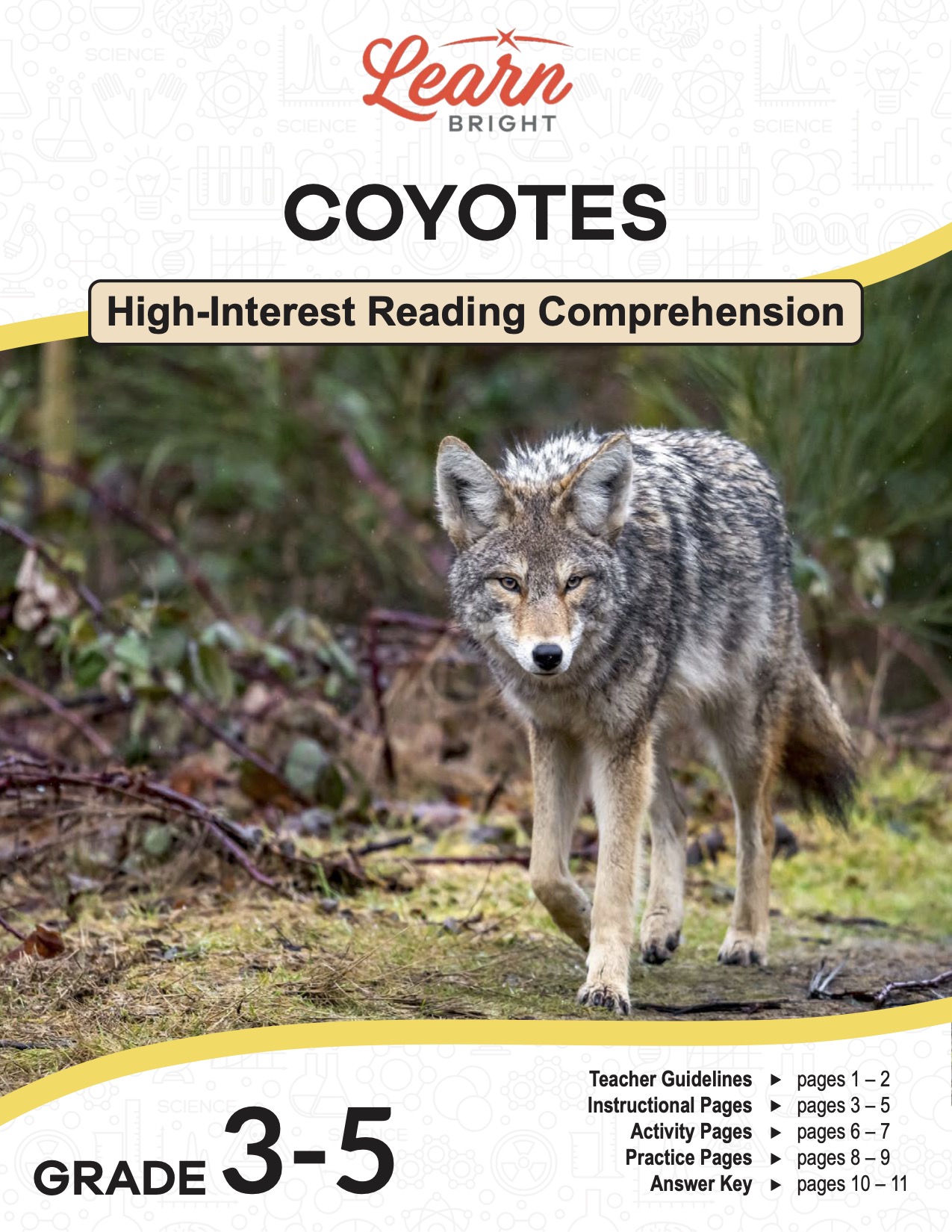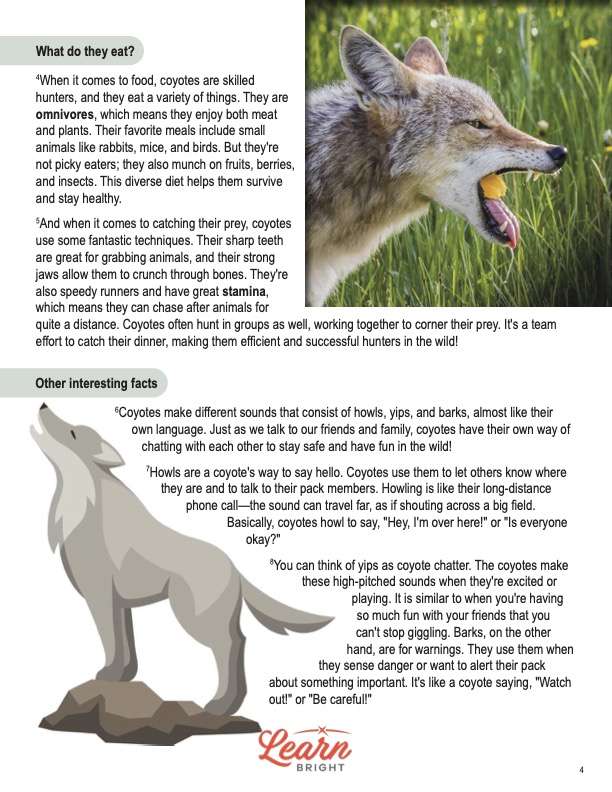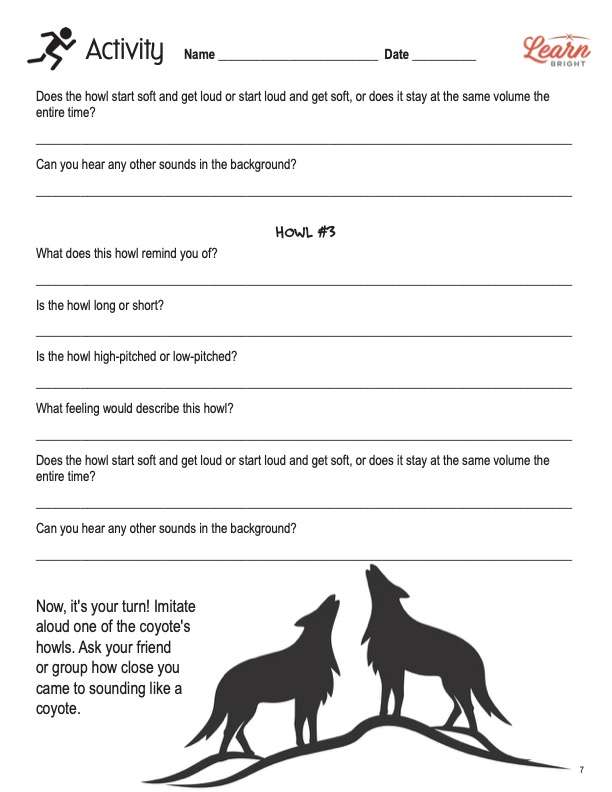Description
What our Coyotes lesson plan includes
Lesson Objectives and Overview: Coyotes is a high-interest reading comprehension lesson plan. As such, students will practice various close reading and comprehension skills. In addition, they will learn about coyotes’ habitat, diet, and behaviors. This lesson is for students in 3rd grade, 4th grade, and 5th grade.
Classroom Procedure
Every lesson plan provides you with a classroom procedure page that outlines a step-by-step guide to follow. You do not have to follow the guide exactly. The guide helps you organize the lesson and details when to hand out worksheets. It also lists information in the yellow box that you might find useful. You will find the lesson objectives, state standards, and number of class sessions the lesson should take to complete in this area. In addition, it describes the supplies you will need as well as what and how you need to prepare beforehand.
Teacher Notes
The paragraph on this page gives you a little more information on the lesson overall and describes what you may want to focus your teaching on. It explains that you can teach this lesson in a whole-class setting or as an independent, small-group activity. The blank lines are available for you to write out any thoughts or ideas you have as you prepare.
COYOTES LESSON PLAN CONTENT PAGES
What Are Coyotes?
The Coyotes lesson plan contains three content pages. To start off, it provides a small box with basic background information about coyotes. Coyotes are mammals that live in North and Central America. They are omnivores because they eat meats and vegetation. In general, they can live for up to 10 years.
Coyotes are fascinating creatures with some unique physical traits. They’re about the size of a medium- sized dog with fur in various colors including gray, brown, or red. One of their key features is their long, bushy tail that helps them balance and communicate with each other. Coyotes have sharp teeth like other carnivores and strong jaws so that they can eat a variety of foods. Their excellent hearing abilities help them detect sounds from afar, making them skilled hunters. Coyotes also have a remarkable sense of smell, which aids them in tracking prey and communicating with other members of their pack through scent marking.
Coyotes live in lots of different places in North and Central America. They hang out in grasslands, deserts, forests, towns, and cities! These animals are habitat experts. They make homes in various spots, from burrows in the ground to cozy caves. Coyotes are the ultimate survival experts because they can adapt to multiple environments—that’s impressive!
These adaptable animals are social and often live in groups called packs. A pack is like a family, led by a dominant mom and dad coyote known as the alpha pair. These alpha coyotes are the leaders and make the decisions for the group. Sometimes, older brothers and sisters from previous years are part of the group. The packs work together to find food and protect their territory from other coyotes.
Coyote Diet
When it comes to food, coyotes are skilled hunters, and they eat a variety of things. They are omnivores, which means they enjoy both meat and plants. Their favorite meals include small animals like rabbits, mice, and birds. But they’re not picky eaters; they also munch on fruits, berries, and insects. This diverse diet helps them survive and stay healthy.
And when it comes to catching their prey, coyotes use some fantastic techniques. Their sharp teeth are great for grabbing animals, and their strong jaws allow them to crunch through bones. They’re also speedy runners and have great stamina, which means they can chase after animals for quite a distance. Coyotes often hunt in groups as well, working together to corner their prey. It’s a team effort to catch their dinner, making them efficient and successful hunters in the wild!
Other Interesting Facts
Coyotes make different sounds that consist of howls, yips, and barks, almost like their own language. Just as we talk to our friends and family, coyotes have their own way of chatting with each other to stay safe and have fun in the wild!
Howls are a coyote’s way to say hello. Coyotes use them to let others know where they are and to talk to their pack members. Howling is like their long-distance phone call—the sound can travel far, as if shouting across a big field. Basically, coyotes howl to say, “Hey, I’m over here!” or “Is everyone okay?”
You can think of yips as coyote chatter. The coyotes make these high-pitched sounds when they’re excited or playing. It is similar to when you’re having so much fun with your friends that you can’t stop giggling. Barks, on the other hand, are for warnings. They use them when they sense danger or want to alert their pack about something important. It’s like a coyote saying, “Watch out!” or “Be careful!”
Why Coyotes Are Important to the Environment
Coyotes play a vital role in our environment as nature’s helpers. They help keep the balance in ecosystems by controlling the populations of small animals like rabbits and mice. If there were too many of these little critters running around, it could cause problems for plants and other animals. Coyotes also eat some plants and fruits, which helps spread seeds around, making them nature’s gardeners too. So, they’re like the cleanup crew and gardeners of the wild world!
Now, when it comes to whether coyotes are endangered, the good news is that they are not endangered at all! Remember, coyotes are pretty good at adapting to different environments, which is why they can be found in many places across North and Central America. They are survivors because they’re so good at finding food and homes. You don’t have to worry that coyotes will disappear from the wild anytime soon. They’re here to stay and continue doing their important job in our ecosystems!
COYOTES LESSON PLAN WORKSHEETS
The Coyotes lesson plan includes two worksheets: an activity worksheet and a practice worksheet. Each one will help students solidify their grasp of the material they learned throughout the lesson. You can refer to the classroom procedure guidelines to know when to hand out each worksheet.
HOWLING ACTIVITY WORKSHEET
For the activity, students will find three different coyote howl sounds on the internet. They will listen to each one and answer a series of six questions about it. For instance, they will explain what the sound reminds them of or wether the howl is long or short. Once all the students have finished the worksheet, they can take turns trying to sound like the coyote howls they listened to.
COYOTES PRACTICE WORKSHEET
The practice worksheet requires students to answer a series of 11 questions. These questions all relate to the content pages, so students will need to refer to them often for the answers. In addition, each question provides which reading tool the question corresponds to, such as text feature, vocabulary, or comprehension.
Worksheet Answer Keys
At the end of the lesson plan document is an answer key for the practice worksheet. The correct answers are all in red to make it easier for you to compare them with students’ responses. If you choose to administer the lesson pages to your students via PDF, you will need to save a new file that omits these pages. Otherwise, you can simply print out the applicable pages and keep these as reference for yourself when grading assignments.










